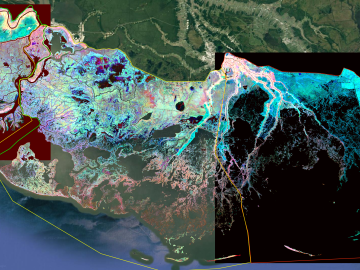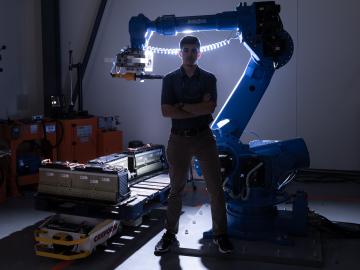
Filter News
Area of Research
- (-) Biology and Environment (30)
- (-) Energy Science (29)
- (-) National Security (30)
- (-) Nuclear Science and Technology (6)
- Advanced Manufacturing (1)
- Biology and Soft Matter (1)
- Electricity and Smart Grid (1)
- Fuel Cycle Science and Technology (1)
- Fusion and Fission (4)
- Isotopes (2)
- Materials (35)
- Materials for Computing (6)
- Neutron Science (12)
- Quantum information Science (1)
- Supercomputing (36)
News Topics
- (-) Advanced Reactors (6)
- (-) Big Data (11)
- (-) Grid (16)
- (-) Materials Science (10)
- (-) Nanotechnology (5)
- (-) National Security (25)
- (-) Physics (2)
- (-) Polymers (2)
- 3-D Printing/Advanced Manufacturing (26)
- Artificial Intelligence (13)
- Bioenergy (36)
- Biology (47)
- Biomedical (12)
- Biotechnology (8)
- Buildings (11)
- Chemical Sciences (7)
- Clean Water (11)
- Composites (3)
- Computer Science (24)
- Coronavirus (12)
- Cybersecurity (13)
- Energy Storage (21)
- Environment (73)
- Exascale Computing (4)
- Fossil Energy (1)
- Frontier (3)
- Fusion (6)
- High-Performance Computing (15)
- Hydropower (6)
- Isotopes (2)
- Machine Learning (12)
- Materials (7)
- Mathematics (4)
- Mercury (7)
- Microelectronics (1)
- Microscopy (9)
- Molten Salt (1)
- Neutron Science (6)
- Nuclear Energy (20)
- Partnerships (6)
- Quantum Science (2)
- Security (8)
- Simulation (9)
- Space Exploration (2)
- Summit (9)
- Transportation (17)
Media Contacts

Sreenivasa Jaldanki, a researcher in the Grid Systems Modeling and Controls group at the Department of Energy’s Oak Ridge National Laboratory, was recently elevated to senior membership in the Institute of Electrical and Electronics Engineers, or IEEE.

In 1993 as data managers at ORNL began compiling observations from field experiments for the National Aeronautics and Space Administration, the information fit on compact discs and was mailed to users along with printed manuals.

For 25 years, scientists at Oak Ridge National Laboratory have used their broad expertise in human health risk assessment, ecology, radiation protection, toxicology and information management to develop widely used tools and data for the U.S. Environmental Protection Agency as part of the agency’s Superfund program.

Carl Dukes’ career as an adept communicator got off to a slow start: He was about 5 years old when he spoke for the first time. “I’ve been making up for lost time ever since,” joked Dukes, a technical professional at the Department of Energy’s Oak Ridge National Laboratory.

Tom Karnowski and Jordan Johnson of ORNL have been named chair and vice chair, respectively, of the East Tennessee section of the Institute of Electrical and Electronics Engineers, or IEEE.

Madhavi Martin brings a physicist’s tools and perspective to biological and environmental research at the Department of Energy’s Oak Ridge National Laboratory, supporting advances in bioenergy, soil carbon storage and environmental monitoring, and even helping solve a murder mystery.

Mike Huettel is a cyber technical professional. He also recently completed the 6-month Cyber Warfare Technician course for the United States Army, where he learned technical and tactical proficiency leadership in operations throughout the cyber domain.

Cody Lloyd became a nuclear engineer because of his interest in the Manhattan Project, the United States’ mission to advance nuclear science to end World War II. As a research associate in nuclear forensics at ORNL, Lloyd now teaches computers to interpret data from imagery of nuclear weapons tests from the 1950s and early 1960s, bringing his childhood fascination into his career

After being stabilized in an ambulance as he struggled to breathe, Jonathan Harter hit a low point. It was 2020, he was very sick with COVID-19, and his job as a lab technician at ORNL was ending along with his research funding.

Wildfires have shaped the environment for millennia, but they are increasing in frequency, range and intensity in response to a hotter climate. The phenomenon is being incorporated into high-resolution simulations of the Earth’s climate by scientists at the Department of Energy’s Oak Ridge National Laboratory, with a mission to better understand and predict environmental change.


